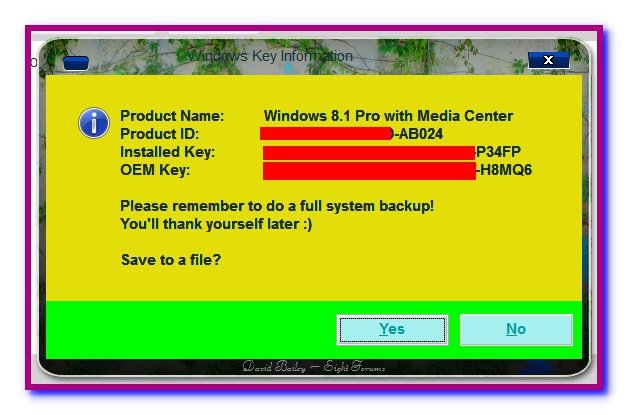
- Messages
- 606
- Location
- South Coast NSW, Australia
Brother's new laptop has a 750GB drive, he wanted to partition it into two equal halves.
All went well, and everything appeared to be a success. Until he re-booted. And of course
it wouldn't. Repair attempts all failed. It wouldn't perform any of the reset or refresh options
nor would system restore initialise.
No, he didn't create any recovery media, and no, he didn't record the product key (assuming
it would be on a sticker somewhere on the machine or in the packaging/documentation.
It wasn't).
I've managed to get it running on an un-activated copy of my Win 8 so he could retrieve his
files, and the machine is usable at the moment, but not activated. His original setup is saved
in the windows.old folder.
What I need to know is, how to get a clean installation of Windows on there, how to find/get/
retrieve the legal product key, and how to activate it again? I have no experience with UEFI
BIOSes.
His machine is a Toshiba Satellite originally running Windows 8, and has a UEFI BIOS. Secure
boot is currently enabled (all settings are defaults), but can be turned off.
He won't be too upset if he has to sacrifice his factory recovery partition(s) in order to get a
clean install.
Any ideas?
Wenda.
All went well, and everything appeared to be a success. Until he re-booted. And of course
it wouldn't. Repair attempts all failed. It wouldn't perform any of the reset or refresh options
nor would system restore initialise.
No, he didn't create any recovery media, and no, he didn't record the product key (assuming
it would be on a sticker somewhere on the machine or in the packaging/documentation.
It wasn't).
I've managed to get it running on an un-activated copy of my Win 8 so he could retrieve his
files, and the machine is usable at the moment, but not activated. His original setup is saved
in the windows.old folder.
What I need to know is, how to get a clean installation of Windows on there, how to find/get/
retrieve the legal product key, and how to activate it again? I have no experience with UEFI
BIOSes.
His machine is a Toshiba Satellite originally running Windows 8, and has a UEFI BIOS. Secure
boot is currently enabled (all settings are defaults), but can be turned off.
He won't be too upset if he has to sacrifice his factory recovery partition(s) in order to get a
clean install.
Any ideas?
Wenda.
My Computer
System One
-
- OS
- Windows 8.1 'Ultimate' RTM 64 bit (Pro/WMC).
- Computer type
- Laptop
- System Manufacturer/Model
- Acer AS8951G 'Desktop Replacement'.
- CPU
- i7-2670QM@2.2/3.1Ghz.
- Motherboard
- Acer
- Memory
- 8GB@1366Mhz.
- Graphics Card(s)
- GeForce GT555M 2GB DDR3
- Sound Card
- Realtek HD w/Dolby 5.1 surround.
- Monitor(s) Displays
- Built-in. Non-touch.
- Screen Resolution
- 18/4" 1920x1080 full-HD.
- Hard Drives
- Toshiba 750GBx2 internal. 1x2TB, 2x640GB, 1x500GB external.
- PSU
- Stock.
- Case
- Laptop.
- Cooling
- Stock.
- Keyboard
- Full 101-key
- Mouse
- USB cordless.
- Browser
- IE11, Firefox, Tor.
- Antivirus
- Windows Defender, MalwareBytes Pro.
- Other Info
- BD-ROM drive.






